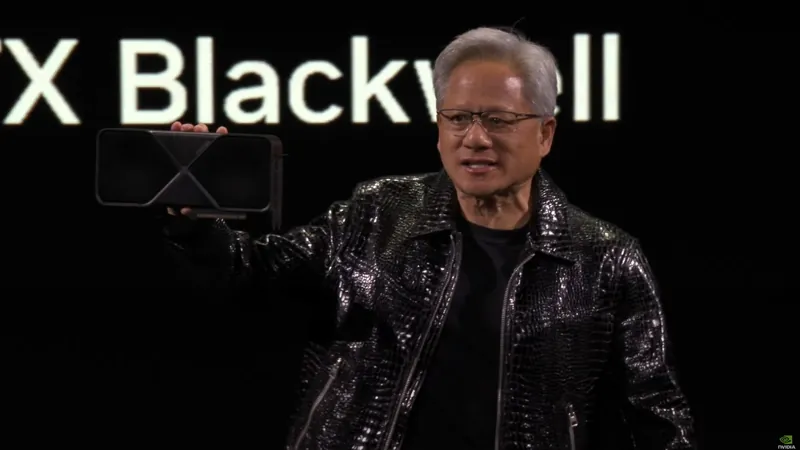
Nvidia Embraces an 'Apple-Style' Approach to Dominate the AI Market
2025-03-23
Author: Mei
Nvidia and Apple may seem like entirely different tech behemoths, but recent developments suggest they're mirroring each other's strategies more than ever. Currently ranked as the second and first wealthiest companies globally, respectively, these giants are completely redefining their markets. They are leveraging their significant market positions to ensure they maintain supremacy over their product categories and create an ecosystem that entices users to stay loyal.
The Game-Changer: AI's iPhone Moment
Nvidia CEO Jensen Huang's assertion that we are witnessing the "iPhone moment of artificial intelligence" resonates throughout the industry. This statement isn't merely about the rise of AI technology but underscores a pivotal shift, echoing the initial struggles of the iPhone. When Apple first launched its handset, it faced substantial challenges due to pricing and features. However, after introducing the iPhone 3G and the App Store, the device became a household name.
Similarly, Nvidia traces its journey back to 2007 with the CUDA software stack, which gained momentum a decade later as neural networks began gaining traction in tech circles. The landmark performance boost achieved when Alex Krizhevsky trained a neural network using Nvidia GPUs marked a turning point for the company. Fast forward to today, and Nvidia grips over 90% of the AI GPU market, thanks in large part to its relentless focus on CUDA development.
Software Over Hardware: Nvidia's Strategy
Both Apple and Nvidia realized that success hinges on cultivating a robust software ecosystem. While hardware plays a role, it’s the software that ultimately drives sales. Nvidia's introduction of Deep Learning Super Sampling (DLSS) showcases its commitment to enhancing gaming experiences, backing its hardware indirectly. Even if its newest RTX 5070 cards don't dazzle on a standalone basis, their integration into Nvidia's expansive software ecosystem keeps consumers engaged.
Harnessing the Power of Scarcity
Scarcity is a persuasive marketing strategy both Nvidia and Apple have mastered. Apple fans line up overnight for new iPhone releases, while Nvidia seized on GPU shortages that persisted during the pandemic. With the RTX 5090’s expected price around $2,000, secondary market values hover near $4,000, creating an air of urgency around purchasing. Once unattainable high-end GPUs are now viewed as coveted collector's items, stimulating quick buying decisions among consumers.
Historically, many Nvidia products justified their price due to high demand from cryptocurrency miners or the pandemic's acceleration of home computing needs. However, the current scenario lacks substantial justification. The ongoing availability issues with GPUs fuel speculation that Nvidia could be subtly exploiting this scarcity for profit.
Marketing and Performance Measurement
Both Nvidia and Apple have utilized ambiguous marketing practices to create buzz around their products. In 2021, Apple claimed its M1 Ultra chip could surpass the performance of the highest-end RTX 3090, though comparisons were questionable and left consumers looking for concrete evidence. Nvidia, too, fell into similar traps with its RTX 5070, claiming it could achieve RTX 4090-level performance through its innovative Multi-Frame Generation technology. While clever marketing grabs attention, it often leads to confusion over actual product capabilities.
Driving Toward a New Era
Despite emerging competitors like Deepseek, Nvidia remains at the forefront of both enterprise and consumer markets. With its current momentum, it is adapting its strategies to not just reach the top but maintain its leading status. The company's approach increasingly resembles Apple's, as it builds a culture of exclusivity around product releases and fosters a closed software ecosystem that enhances customer loyalty.
In summary, while Nvidia and Apple operate in different markets, the similarities in their strategies are becoming apparent. The way they market products, control software ecosystems, and create a sense of urgency among consumers hints at a broader trend where both companies pull from the same successful playbook. As Nvidia continues to innovate and expand its influence, it's clear it may very well be entering its own “Apple era.”




 Brasil (PT)
Brasil (PT)
 Canada (EN)
Canada (EN)
 Chile (ES)
Chile (ES)
 Česko (CS)
Česko (CS)
 대한민국 (KO)
대한민국 (KO)
 España (ES)
España (ES)
 France (FR)
France (FR)
 Hong Kong (EN)
Hong Kong (EN)
 Italia (IT)
Italia (IT)
 日本 (JA)
日本 (JA)
 Magyarország (HU)
Magyarország (HU)
 Norge (NO)
Norge (NO)
 Polska (PL)
Polska (PL)
 Schweiz (DE)
Schweiz (DE)
 Singapore (EN)
Singapore (EN)
 Sverige (SV)
Sverige (SV)
 Suomi (FI)
Suomi (FI)
 Türkiye (TR)
Türkiye (TR)
 الإمارات العربية المتحدة (AR)
الإمارات العربية المتحدة (AR)